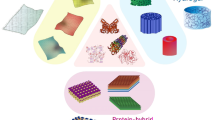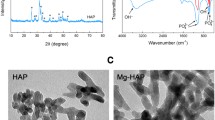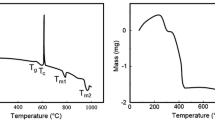Abstract
Purpose of Work
We have developed a strategy of designing multi-functional extracellular matrix proteins for functionalizing bone tissue engineering scaffolds and other biomedical surfaces to achieve improvements in bone grafting, bone repair and bone regeneration.
We developed a novel extracellular matrix protein designed to have a cell adhesive RGD sequence derived from fibronectin and active functional unit of osteocalcin (OC) containing Ca2+-binding sites for immobilization to mineral component of bone, hydroxyapatite (HA). The fusion protein, designated FNRGD/OC, was expressed in Escherichia coli and purified with affinity chromatography using a His-tag. The resultant FNRGD/OC fusion protein preferentially bound to HA, promoted cell adhesive activity, and stimulated differentiation of MC3T3-E1 cell.




Similar content being viewed by others
References
Buck CA, Horwitz AF (1987) Cell surface receptors for extracellular matrix molecules. Annu Rev Cell Biol 3:179–205
Cutler SM, Garcia AJ (2003) Engineering cell adhesive surfaces that direct integrin alpha5beta1 binding using a recombinant fragment of fibronectin. Biomaterials 24:1759–1770
Damsky CH (1999) Extracellular matrix-integrin interactions in osteoblast function and tissue remodeling. Bone 25:95–96
De Arcangelis A, Georges-Labouesse E (2000) Integrin and ECM functions: roles in vertebrate development. Trends Genet 16:389–395
Delmas PD, Stenner DD, Romberg RW, Riggs BL, Mann KG (1984) Immunochemical studies of conformational alterations in bone gamma-carboxyglutamic acid containing protein. Biochemistry 23:4720–4725
Huang H, Zhao Y, Liu Z, Zhang Y, Zhang H, Fu T, Ma X (2003) Enhanced osteoblast functions on RGD immobilized surface. J Oral Implantol 29:73–79
Hubbell JA (1999) Bioactive biomaterials. Curr Opin Biotechnol 10:123–129
Hunter GK, Hauschka PV, Poole AR, Rosenberg LC, Goldberg HA (1996) Nucleation and inhibition of hydroxyapatite formation by mineralized tissue proteins. Biochem J 317:59–64
Hynes RO (1987) Integrins: a family of cell surface receptors. Cell 48:549–554
Khadra M, Lyngstadaas SP, Haanaes HR, Mustafa K (2005) Effect of laser therapy on attachment, proliferation and differentiation of human osteoblast-like cells cultured on titanium implant material. Biomaterials 26:3503–3509
Kim TI, Jang JH, Chung CP, Ku Y (2003) Fibronectin fragment promotes osteoblast-associated gene expression and biological activity of human osteoblast-like cell. Biotechnol Lett 25:2007–2011
Kim JH, Park S, Kim HW, Jang JH (2007a) Recombinant expression of mouse osteocalcin protein in Escherichia coli. Biotechnol Lett 29:1631–1635
Kim TI, Lee G, Jang JH, Chung CP, Ku Y (2007b) Influence of RGD-containing oligopeptide-coated surface on bone formation in vitro and in vivo. Biotechnol Lett 29:359–363
Kim HW, Kang W, Jeon E, Jang JH (2010) Construction and expression of a recombinant fibronectinIII10 protein for integrin-mediated cell adhesion. Biotechnol Lett 32:29–33
LeBaron RG, Athanasiou KA (2000) Extracellular matrix cell adhesion peptides: functional applications in orthopedic materials. Tissue Eng 6:85–103
Lutolf MP, Hubbell JA (2005) Synthetic biomaterials as instructive extracellular microenvironments for morphogenesis in tissue engineering. Nat Biotechnol 23:47–55
Ruoslahti E (1988) Fibronectin and its receptors. Annu Rev Biochem 57:375–413
Acknowledgments
This work was supported by the Korea Research Foundation Grant funded by the Korean Government (MOEHRD) (KRF-2007-314-E00183), the Korea Science and Engineering Foundation (KOSEF) Grant funded by the Korea government (MOST) (R01-2007-000-20183), the Grants (#2009-0093829: priority research centers program, and #M10755080002-07N5508-00212) through the National Research Foundation (NRF) funded by the Ministry of Education, Science and Technology.
Author information
Authors and Affiliations
Corresponding author
Additional information
Wonmo Kang and Tai-Il Kim contributed equally to this work.
Rights and permissions
About this article
Cite this article
Kang, W., Kim, TI., Yun, Y. et al. Engineering of a multi-functional extracellular matrix protein for immobilization to bone mineral hydroxyapatite. Biotechnol Lett 33, 199–204 (2011). https://doi.org/10.1007/s10529-010-0412-8
Received:
Accepted:
Published:
Issue Date:
DOI: https://doi.org/10.1007/s10529-010-0412-8




